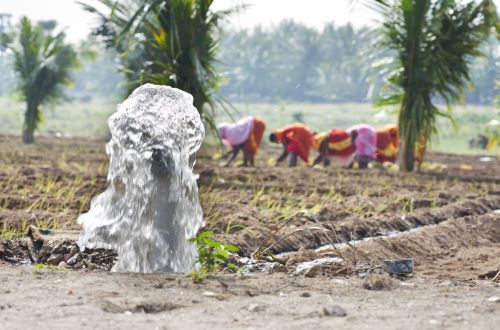Could overuse of groundwater jeopardize Tamil Nadu’s Green Revolution?
Overuse of groundwater for irrigation in southeastern India threatens to undermine food production, reversing years of agricultural development, according to new research by the International Water Management Institute (IWMI).
Scientists found that farmers in Tamil Nadu state are pumping out more water than is naturally replenished by the rains each year. Already some 95% of open wells in the state are dry, and the amount of irrigated land has fallen by half in the last decade due to sources of groundwater drying up.
The situation could threaten the state’s production of staple foods like rice, bananas and groundnut.
The findings have just been published in the journal Water Resources Management.

“It’s a precarious situation,” said IWMI’s Pennan Chinnasamy, who led the study.
“This is one of the most important agricultural states in India, and largely depends on groundwater to produce food. Without groundwater, the sector could collapse, wiping out the benefits of agricultural development achieved in recent years.”
Unsustainable use of groundwater is widespread in India. The popularity of low-cost motorized pumps and generous state subsidies on fuel, have resulted in a proliferation of tube wells – pipes sunk into the ground to pump groundwater – for irrigation. While groundwater irrigation has helped trigger a boom in food production, it has caused the water table in some areas to plummet. This in turn has affected the water levels in rivers, lakes and ponds.
For those areas close to the coast – such as in Tamil Nadu’s state capital Chennai – the situation could become particularly severe. As groundwater levels fall, there is a risk that seawater will be drawn into the aquifer through the porous bedrock, contaminating water used for drinking and irrigation. If applied to farmland, this water can result in salty soil that many food crops are unable to tolerate. Saline soils take years to rehabilitate.
The researchers used NASA satellite data to establish rates of groundwater extraction and replenishment in Tamil Nadu during a period of agricultural intensification from 2002-2012. They found that farmers were taking out on average 8% more than was being naturally replenished, leading to a decline in groundwater levels at a rate of 1.4 m per year.
The researchers hope the findings will help focus the attention of policy makers on the introduction of more efficient irrigation systems, and work to accelerate the recharge of aquifers.
“Almost 90% of the state’s surface water irrigation sources are dry; hence, groundwater is the only irrigation source in many areas,” continued Chinnasamy. “That means it is imperative to regulate groundwater use and pilot test artificial aquifer recharge systems such as check dams and ponds to increase groundwater recharge.
“In addition, field observation methods need to be combined with interdisciplinary methods – especially remote sensing tools, agricultural yield estimations, future climate projections, social and economic stress indices, to better understand the groundwater issue.”
This work relates to the Improved Village scale groundwater recharge and management for agriculture and livelihood development in India (MALWI) project, funded by the CGIAR Research Program on Water, Land and Ecosystems (WLE) and the CGIAR Research Program on Climate Change, Agriculture and Food Security (CCAFS).

